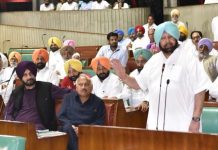
As Narendra Modi Government completed four years on May 26, 2018, the Prime Minister tweeted with the hashtag “saaf niyat, sahi vikas” with a series of charts, graphics and video to underline the achievements of his government. Congress President Rahul Gandhi was quick to give his report card A+ for self-promotion and F for job creation.
Prime Minister Narendra Modi -led NDA Government highlighted its achievements, saying that over the last four years, development has become a “vibrant mass movement.”
To further highlight the excellent work of his government, PM Modi tweeted, “On this day in 2014, we began our journey of working towards India’s transformation.” “Over the last four years, development had become a vibrant mass movement, with every citizen feeling involved in India’s growth trajectory. 125 crore Indians are taking India to great heights,” he said. “I bow to my fellow citizens for their unwavering faith in our government. This support and affection is the biggest source of motivation and strength for the entire government.”
The Prime Minister stressed that his government would continue to serve the people “with the same vigour and dedication”. “For us, it is always India First,” he wrote. Modi said with complete integrity and the best intent that his government had taken “futuristic and people-friendly decisions” that was laying the foundations of a new India. The BJP President, Amit Shah, echoed similar sentiments and said that with the 2016 surgical strikes conducted across the Line of Control (LoC), the government exhibited its political willingness to take on the country’s adversaries.
“Prime Minister Narendra Modi has ended politics of appeasement, dynasty and casteism, and ushered politics of development,” Shah said.
The government has also resolved the long-pending issue of One Rank One Pension (OROP) within a year of coming to power. He also said that several measures such as the constitution of an Special Investigating Team (SIT) to curb black money were taken by the government. The black money issue was one of the main poll planks of the BJP during the 2014 election campaign. “Modi dispensation is sensitive and committed towards development of villages,” Shah said, noting that while focusing on the rural areas, the due emphasis was also given to urban areas.
Congress not amused

As the BJP government completes four years in power at the Centre, the Congress described the period as that of ‘treachery, trickery, revenge and lies’. Releasing a booklet titled ‘India betrayed’ on the occasion of the fourth anniversary of the NDA government, Congress leaders Ghulam Nabi Azad, Ashok Gehlot and Randeep Surjewala said people now know that the Narendra Modi-Amit Shah duo was harmful for the country. They said that an atmosphere of fear and hatred has been created under the NDA rule. “People now know that Modi-Amit Shah duo is harmful for the country. Four years of the Modi government can be defined in four terms — treachery, trickery, revenge and lies,” said Surjewala.
Referring to alleged atrocities on Dalits, tribals, minorities, and women, Azad said that nobody is safe in the country under the BJP rule. Everyone is getting sleepless nights. “Atmosphere of fear, hatred, and violence was created in the last four years of the Modi government,” AICC General Secretary Ashok Gehlot said at the joint press conference.
The Congress released the booklet ‘India betrayed’ on the four years of BJP’s “misrule”, both in English and Hindi, and asked a set of forty questions to Prime Minister Narendra Modi. They also released and showed a short-film describing the prevailing atmosphere in the country. A senior Congress leader Oommen Chandy also posed a barrage of questions to PM Modi on issues ranging from the fuel price hike to the Lokpal Bill. In a tweet, Chandy requested the prime minister to “be kind enough to answer.”
Ecstasy & gloom
The government claims to be free from corruption. Though opposition has leveled unsubstantiated charges against the government, the greatest achievement of this government is to provide a corruption free regime. It is remarkable that there is no allegation of corruption against the Modi government in this period. It claims 100 per cent electrification of the villages in the country. The government has increased the total LPG Consumer base to over 20 crore in 2017 from 14 crore in 2014. The Modi Government ended the VVIP culture by doing away with beacons for everyone. It got crores of people in the banking net under its financial inclusion programme by allowing them to open Jan Dhan accounts with zero balance. The government continued with alacrity with the UPA government’s much touted scheme of direct benefit of subsidy and brought all welfare and subsidy schemes under Direct Benefit Transfer to prevent theft, leakage of subsidy to fake and fictitious persons.
The government has done well andkept it simple: do away with redundant and obsolete laws. In 2016, the Lok Sabha repealed 1,175 of 1,827 laws that were identified as obsolete, and many other steps were taken to make lives of common people easier. Many of these reforms went unnoticed in the four years of Modi-led NDA government.
However, the government failed to pass the Land Acqusition Act and Lokpal Bill which has adversely affected the Make-in-India campaign of the government. You cannot acquire land for any development purpose under the current law. It has failed to create as many jobs as it has promised leading to Congress President giving him a report card of A+ in self-promotion and F in job creation.
The government has also failed to bring peace in Kashmir, which is passing through one of the worst phases of disturbance. It has not come up to expectations to contain the fringe parties of Hindutva brigade who are flaring up peace and harmony in our country thus giving rise to slogans of intolerance.
Small reforms
In 2014, the government decided that there was no need to get documents attested by a gazetted officer or file affidavits for government-related work. After the decision, applicants only need to self-attest the copies of their birth certificates, mark sheets or other documents.The Modi government did away with birth certificates as a mandatory document for availing passport. The government simplified the 1980 rule of securing passports by Indian citizens. Now, Aadhaar and PAN card are among a host of documents that could be used to establish proof of birth. Indian Railways is the lifeline of the country. About 23 million passengers use the services of Railways every day. One of the most important services is Tatkal booking, which allows people to book tickets for immediate travelling. The government launched Rail Connect app last year to ensure Tatakal booking in less than a minute. Moreover, Tatkal booking timings were changed to facilitate hassle-free booking by reducing the load on the server.
A joint report by World Bank and PwC said that the reforms in the area of paying taxes in 2016 made data gathering increasingly automated. The IT Department started using modern enterprise resource planning (ERP) software to make the process automated. With the introduction of electronic payments of state insurance contributions and social security contributions, the time required to comply with tax liabilities came down significantly.
Ease of transaction greatly improved with the launch of mobile wallets and ultimately the Unified Payments Interface or UPI, which was launched just months before demonetisation. UPI allows a user to transfer money from one bank account to another instantly using a cellphone and is set to trump the popularity of e-wallets that shot to fame right after demonetisation. E-wallets allow you to make payments without using internet banking, but the wallet itself needs to be loaded first.
According to data updated on Pradhan Mantri Jan Dhan Yojana’s website, there are about 316 million beneficiaries with deposits of around 81,203.59 crore. If Jan Dhan got the economy banked, insurance through the Pradhan Mantri Jeevan Jyoti Bima Yojana (life insurance) and Pradhan Mantri Suraksha Bima Yojana (accident insurance) have given financial comfort at rock bottom prices.
The big bang reform has been the announcement of the National Health Protection Scheme which has the potential to reform the health industry. The insurance cover of 5 lakh is more than what an average individual buys. The scheme will not only increase longevity of citizens of India as it will make medical care affordable and accessible, its biggest boon will be an upliftment of the medical infrastructure in rural as well as urban areas.
One of the big steps forward for better order in the real estate market was the Real Estate (Regulation and Development) Act (RERA). On 1 May 2016, the sector got its first regulator. RERA focuses on transparency and safeguarding home buyers’ interest by curbing the rampant practice of siphoning off funds from one project to another by the developers leading to construction delays. But the dampener has been in implementation. Even after two years, many states have not implemented the Act completely, which is affecting homebuyers’ confidence and expectation.
The implementation of goods and services tax (GST) is yet another move to increase transparency. GST collapses many taxes into one tax and the idea is to reduce the tax burden and also increase compliance. This is a step towards formalising the economy and a result of efforts such as these has been an increase in the tax base. In the last four years, there has been a substantial increase in the number of returns filed and the amount of tax collected. According to the income tax department, while 37.9 million ITRs were filed in FY14, 68.4 million ITRs were filed in FY18, an increase of 80.5%.
Reforms undertaken by the government focus on creating better infrastructure, streamlining economic activity and simplifying transactions, the impact of which will percolate to individuals in times to come. But the reforms have not yet created progressively more jobs and there are few signs that black money has been brought back into the system or redistributed.
Concerns remain on the job creation front and curbing of black money. The direction is right, but the journey has been bumpy.
Modi mania
The BJP is now ruling alone or with allies — Jammu and Kashmir, Jhar-khand, Sikkim, Arunachal Pradesh, Maharashtra, Haryana, Madhya Pradesh, Gujarat, Chhattisgarh, Bihar, Rajasthan, Assam, Nagaland, Meghalaya, Manipur, Goa, Uttar Pradesh, Uttarakhand and Himachal Pradesh.
One often claimed reason is the rise of BJP under the charismatic leadership of Prime Minister Narendra Modi. From Kashmir to Arunachal to Karnataka and Gujarat, the saffron party has spread its footprints in most of the states of the country, while the Congress has effectively shrunk to three — Punjab, Puducherry, and Mizoram .
letters@tehelka.com












